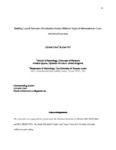Building lexical networks: Preschoolers extract different types of information in cross-situational learning
| dc.contributor.author | Chen, Chi-hsin | |
| dc.contributor.author | Yu, C | |
| dc.date.accessioned | 2022-04-11T10:32:38Z | |
| dc.date.available | 2022-04-11T10:32:38Z | |
| dc.date.issued | 2022-08 | |
| dc.identifier.issn | 0022-0965 | |
| dc.identifier.issn | 1096-0457 | |
| dc.identifier.other | 105430 | |
| dc.identifier.uri | http://hdl.handle.net/10026.1/19028 | |
| dc.description.abstract |
Children's everyday learning environment is semantically structured. For example, semantically related things (e.g., fork and spoon) usually co-occur in the same contexts. The current study examines the effects of semantically structured contexts on preschool-age children's (N = 65, 33 girls, age range: 52-68 months) use of statistical information to learn novel word-object mappings. Children were assigned into one of two conditions, in which objects from the same semantic category repeatedly co-occurred in the same trials (Same-category condition) or objects from different categories repeatedly co-occurred in the same trials (Different-categories condition). Children's word learning performance in the two conditions were comparable. However, their errors at test suggested that information extracted by children in the two conditions differed. Importantly, children in the Same-category condition extracted both statistical and semantic relationships from the stimuli. | |
| dc.format.extent | 105430-105430 | |
| dc.format.medium | Print-Electronic | |
| dc.language | en | |
| dc.language.iso | en | |
| dc.publisher | Elsevier | |
| dc.subject | Cross-situational learning | |
| dc.subject | Child word learning | |
| dc.subject | Semantic information | |
| dc.subject | Co-occurrence frequencies | |
| dc.subject | Error analyses | |
| dc.subject | contextual information | |
| dc.title | Building lexical networks: Preschoolers extract different types of information in cross-situational learning | |
| dc.type | journal-article | |
| dc.type | Journal Article | |
| dc.type | Research Support, N.I.H., Extramural | |
| plymouth.author-url | https://www.webofscience.com/api/gateway?GWVersion=2&SrcApp=PARTNER_APP&SrcAuth=LinksAMR&KeyUT=WOS:000793047600002&DestLinkType=FullRecord&DestApp=ALL_WOS&UsrCustomerID=11bb513d99f797142bcfeffcc58ea008 | |
| plymouth.volume | 220 | |
| plymouth.publication-status | Published | |
| plymouth.journal | Journal of Experimental Child Psychology | |
| dc.identifier.doi | 10.1016/j.jecp.2022.105430 | |
| plymouth.organisational-group | /Plymouth | |
| plymouth.organisational-group | /Plymouth/Faculty of Health | |
| plymouth.organisational-group | /Plymouth/Faculty of Health/School of Psychology | |
| plymouth.organisational-group | /Plymouth/Research Groups | |
| plymouth.organisational-group | /Plymouth/Research Groups/Plymouth Institute of Health and Care Research (PIHR) | |
| plymouth.organisational-group | /Plymouth/Users by role | |
| plymouth.organisational-group | /Plymouth/Users by role/Academics | |
| dc.publisher.place | United States | |
| dcterms.dateAccepted | 2022-03-14 | |
| dc.rights.embargodate | 2023-4-11 | |
| dc.identifier.eissn | 1096-0457 | |
| dc.rights.embargoperiod | Not known | |
| rioxxterms.versionofrecord | 10.1016/j.jecp.2022.105430 | |
| rioxxterms.licenseref.uri | http://www.rioxx.net/licenses/all-rights-reserved | |
| rioxxterms.type | Journal Article/Review |


